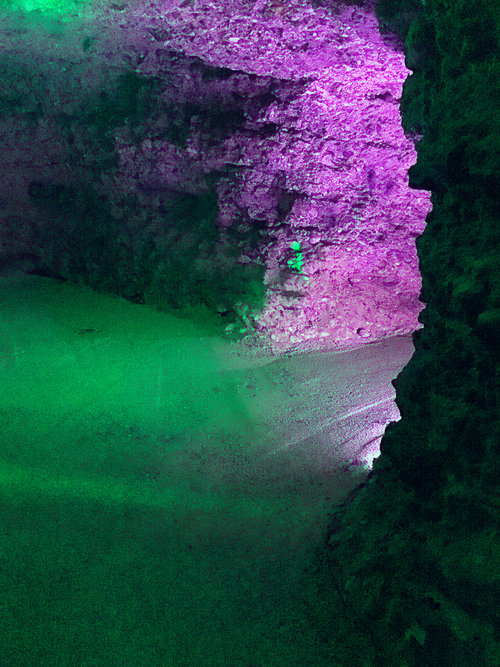Raum- und Klanginstallation |room and sound installation |installation spatiale et sonore
Luftschutzstollen |Air raid shelter | Galerie de protection aérienne
Wals-Siezenheim, 2018 / 19
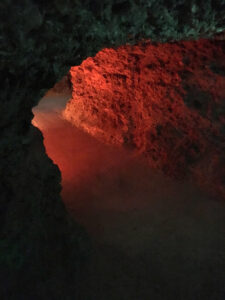
Der Ende 1944 errichtete, etwa 40 Meter lange und unterhalb der Kirche und des Friedhofes der Salzburger Gemeinde Wals-Siezenheim gelegene Luftschutzstollen wurde 2018 anlässlich des zehnjährigen Jubiläums des örtlichen Kulturmuseums Bachschmiede als Kunstraum adaptiert. Zu dessen Eröffnung wurde der Künstler Florian Boehm eingeladen, eine Raum- und Klanginstallation zu entwickeln. Mit einem ortsspezifischen Konzept aus Sprache, Lichtfarben und Filmen verwandelte der Künstler den Luftstollen in einen einheitlichen Erfahrungsraum, der die darin gespeicherten Emotionen transformieren sollte.
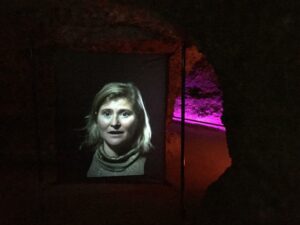
Auf drei Leinwänden wurde jeweils ein filmisches Portrait einer Frau projiziert, die, als innere Monologe konzipiert, über ihre Erfahrungen mit Ängsten, psychischen Schmerzen, der Dunkelheit und Mutproben erzählen. Magdalena Braennland spricht den von Florian Boehm geschriebenen Text einer „rede an ein zwoelfjaehriges maedchen“, Barbara M. Macheiner jenen des „kindes uebermut“ und Yinet Rojas Cardona rezitiert „finde dich in deinem sein“. Alle drei Sprecherinnen zählen auch immer wieder in sich versunken und lassen damit mehrere Reflexionen und Bedeutungsebenen zu: Ein Aneinanderreihen der Ziffern, um die Zeitspanne des zermürbenden Abwartens im Stollen zeitlich einzugrenzen und somit auch die Dauer der Schutzsuche sowie die Anwesenheit der anderen Menschen abzuschätzen. Aber auch als harmloses Variante des kindlichen Versteckspiels, wobei jenes Kind, das anschließend alle anderen auffinden muss, zuerst einmal bis zu einer festgelegten Zahl laut zählt, bevor es mit der Suche beginnen darf.
Trotz seiner Lage unterhalb eines Friedhofes und seiner kühl-feuchten Atmosphäre, interpretierte Florian Boehm den Stollen als eine örtliche Version eines Mutterleibes und reflektierte mit den in der Galerie ausgestellten Arbeiten der Serie „blut.feld“ auf die Bedeutung des Blutes für ein Menschenleben sowie den Körper der Mutter als Beginn des Lebens. Die Papierarbeiten der Serie „tunnel.blick“ dagegen konzentrieren sich auf Wechselspiele zwischen zeichnerischen Assoziationen und sprachlichen Gedanken, die einander bedingen. Die Ergänzung mit den Arbeiten der Werkgruppe „ahnen-portraits“ lassen dahingehend auch Fragen hinsichtlich der Identität zu, da sie als ein Negativ eines herkömmlichen Abbildes eines Menschen gestaltet wurden: Die Form des Oberkörpers in einer Zweidimensionalität ist sichtbar, aber jegliche körperliche Charakterisierung sowie spezifischen Merkmale bleiben ausgespart, so dass nur eine Hülle eines Menschen sichtbar wird, die die Komplexität nach der Erkennbarkeit, dem Ausdruck mit seiner Interpretation und möglichen Eigenschaften, im Verborgenen lässt.
(Text: Gabriele Baumgartner)

blut.feld, 2013-18, ink on paper, each 42 x 34 cm
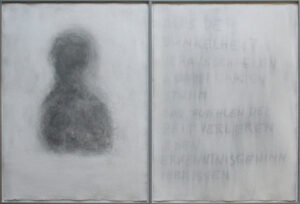
ahnen.portraits, 2018, carbon, graphit on paper, 78 x 108 cm
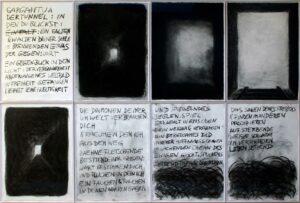
tunnel.blick, 2018, carbon,graphit on paper
The air raid shelter, some 40 metres in length and located below the church and cemetery of the Salzburg community of Wals-Siezenheim, was built in 1944 and, in 2018, was converted into a room for art on the occasion of the ten-year anniversary of the local Bachschmiede cultural museum. For its opening, the artist Florian Boehm was invited to develop a room and sound installation. Using a site-specific concept consisting of speech, projected colours and film, the artist transformed the air raid shelter into a unified space of experience that serves to transform the emotions stored within it.
A filmed portrait of a woman was projected on each of the three screens, who, in what is conceived as an inner monologue, talks about how she experienced fears, mental suffering, darkness and tests of courage. Magdalena Braennland reads the text written by Florian Boehm: „rede an ein zwoelfjaehriges maedchen“ (Speech to a twelve year-old girl), Barbara M. Macheiner reads that of „kindes uebermut“ (Children’s exuberance) and Yinet Rojas Cardona recites „finde dich in deinem sein“ (Find yourself in your being). All three speakers also repeatedly count, lost in themselves and, in so doing, allow for more reflection and levels of meaning: A stringing together of the digits in order to limit the time span of the gruelling wait in the shelter and, as a result, also to estimate the length of the search for shelter and presence of other people. But also as a harmless version of the children’s game of hide and seek where every child has to find all the others and must first count to a set number before the child can start looking for them.
Despite its location under a cemetery and its cool-moist atmosphere, Florian Boehm interpreted the shelter as a local version of a mother’s womb and, with the works exhibited from the „blut.feld“ series, reflected on the meaning of blood for a person’s life and the body of the mother as the beginning of life. The paper works from the „tunnel.blick“ series, on the other hand, concentrate on the interplay between graphic associations and verbal thoughts, which are mutually dependent. Supplementation with the works from the „ahnen-portraits“ (ancestor portraits) work group also allows for corresponding questions of identity given that they were created as a negative of a conventional picture of a person: The shape of the body in two-dimensionality is visible, but any physical characterisation and specific features remain excluded so that only the husk of a person is visible, which leaves the complexity of recognisability, the expression with his interpretation and possible characteristics concealed.
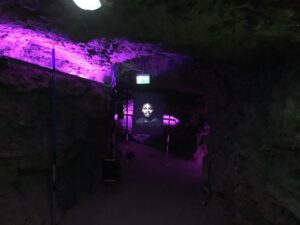
La galerie de protection antiaérienne construite fin 1944, d’une longueur d’env. 40 mètres et située sous l’église et le cimetière de la commune salzbourgeoise de Wals-Siezenheim, a été adaptée en 2018 en tant qu’espace artistique à l’occasion du dixième anniversaire du musée culturel local Bachschmiede. Pour son inauguration, l’artiste Florian Boehm a été invité à développer une installation spatiale et sonore. Grâce à un concept spécifique au lieu, composé de paroles, de couleurs lumineuses et de films, l’artiste a transformé la galerie d’aération en un espace d’expérience homogène, qui devait transformer les émotions qui y étaient stockées.
Sur trois écrans a été projeté le portrait filmé d’une femme qui, conçue comme un monologue intérieur, raconte ses expériences avec la peur, la douleur psychique, l’obscurité et les épreuves de courage. Magdalena Braennland lit le texte d’un « discours à une jeune fille de douze ans » écrit par Florian Boehm, Barbara M. Macheiner celui de « l’enfant surmené » et Yinet Rojas Cardona récite « trouve-toi dans ton être ». Les trois locutrices ne cessent également de compter en se replongeant en elles-mêmes, permettant ainsi plusieurs réflexions et niveaux de signification : une juxtaposition de chiffres pour délimiter dans le temps la durée de l’attente mortifère dans la galerie et ainsi estimer la durée de la recherche d’un abri ainsi que la présence des autres personnes. Mais aussi comme variante inoffensive du jeu de cache-cache enfantin, où l’enfant qui doit ensuite trouver tous les autres doit d’abord payer à haute voix jusqu’à un nombre défini avant de pouvoir commencer sa recherche.
Malgré sa situation en dessous d’un cimetière et son atmosphère fraîche et humide, Florian Boehm a interprété la galerie comme une version locale d’un ventre maternel et a réfléchi, avec les œuvres de la série « blut.feld » exposées à la galerie, à l’importance du sang pour la vie humaine et au corps de la mère comme début de la vie. Les travaux sur papier de la série « tunnel.blick » se concentrent en revanche sur les jeux d’alternance entre les associations de dessins et les pensées verbales qui se conditionnent mutuellement. La complémentarité avec les travaux du groupe d’œuvres « ahnen-portraits » permet également de se poser des questions sur l’identité, car ils ont été conçus comme un négatif de la représentation habituelle d’une personne : la forme de la partie supérieure du corps en deux dimensions est visible, mais toute caractérisation physique ainsi que les caractéristiques spécifiques sont laissées de côté, de sorte que seule l’enveloppe d’une personne est visible, ce qui laisse dans l’ombre la complexité de la reconnaissance, de l’expression avec son interprétation et ses éventuelles caractéristiques.
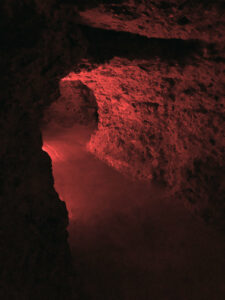
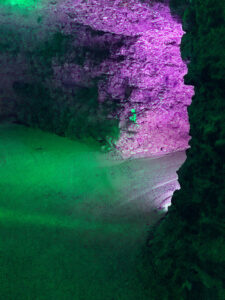
Homepage Florian Boehm: https://bildtonlautmaler.net/
posts on our blog Kultur frei Haus:
Florian Boehm: wandlungen des ich | 77ichs (raum. & klang.installation, 2017)
Günther Wagner, Podcast, Out of the box: #4 Gespräch mit Florian Boehm
Florian Boehm: wandlungen des ich | 77ichs (raum. & klang.installation, 2017)
